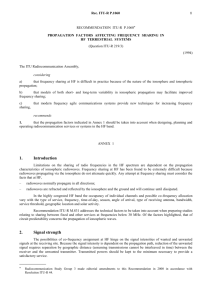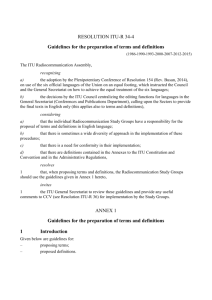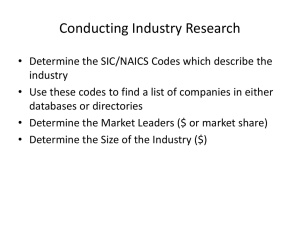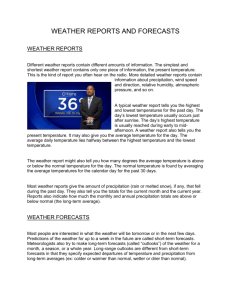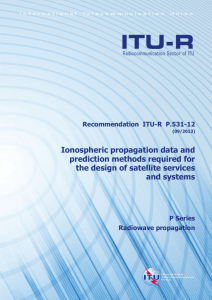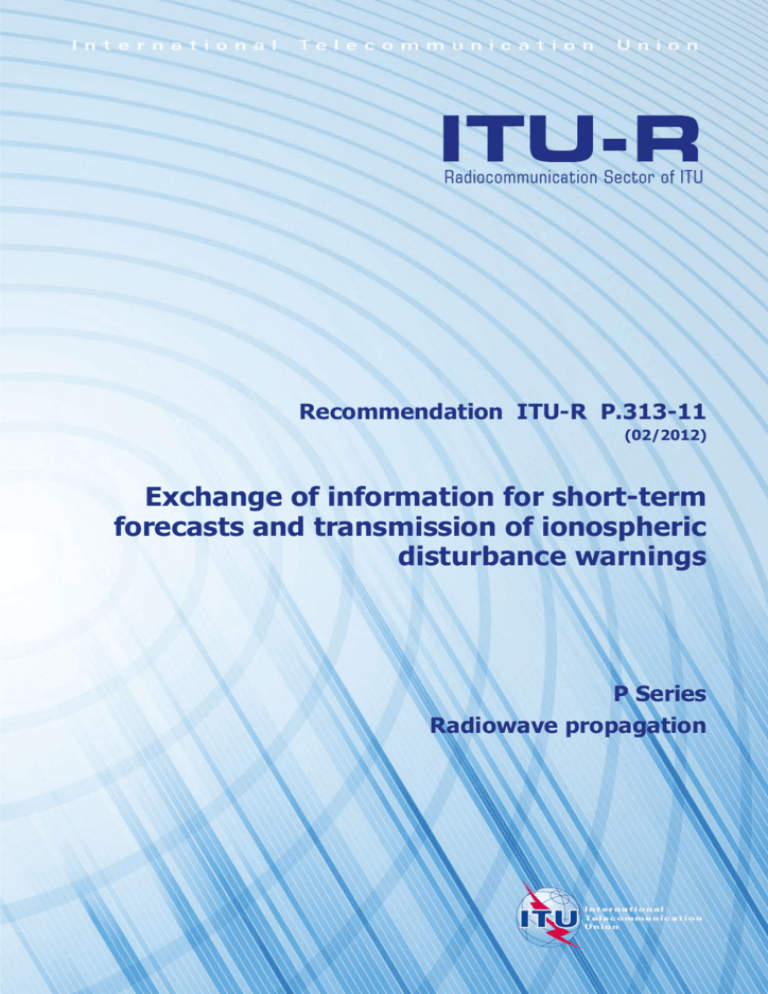
Recommendation ITU-R P.313-11
(02/2012)
Exchange of information for short-term
forecasts and transmission of ionospheric
disturbance warnings
P Series
Radiowave propagation
ii
Rec. ITU-R P.313-11
Foreword
The role of the Radiocommunication Sector is to ensure the rational, equitable, efficient and economical use of the
radio-frequency spectrum by all radiocommunication services, including satellite services, and carry out studies without
limit of frequency range on the basis of which Recommendations are adopted.
The regulatory and policy functions of the Radiocommunication Sector are performed by World and Regional
Radiocommunication Conferences and Radiocommunication Assemblies supported by Study Groups.
Policy on Intellectual Property Right (IPR)
ITU-R policy on IPR is described in the Common Patent Policy for ITU-T/ITU-R/ISO/IEC referenced in Annex 1 of
Resolution ITU-R 1. Forms to be used for the submission of patent statements and licensing declarations by patent
holders are available from http://www.itu.int/ITU-R/go/patents/en where the Guidelines for Implementation of the
Common Patent Policy for ITU-T/ITU-R/ISO/IEC and the ITU-R patent information database can also be found.
Series of ITU-R Recommendations
(Also available online at http://www.itu.int/publ/R-REC/en)
Series
BO
BR
BS
BT
F
M
P
RA
RS
S
SA
SF
SM
SNG
TF
V
Title
Satellite delivery
Recording for production, archival and play-out; film for television
Broadcasting service (sound)
Broadcasting service (television)
Fixed service
Mobile, radiodetermination, amateur and related satellite services
Radiowave propagation
Radio astronomy
Remote sensing systems
Fixed-satellite service
Space applications and meteorology
Frequency sharing and coordination between fixed-satellite and fixed service systems
Spectrum management
Satellite news gathering
Time signals and frequency standards emissions
Vocabulary and related subjects
Note: This ITU-R Recommendation was approved in English under the procedure detailed in Resolution ITU-R 1.
Electronic Publication
Geneva, 2012
ITU 2012
All rights reserved. No part of this publication may be reproduced, by any means whatsoever, without written permission of ITU.
Rec. ITU-R P.313-11
1
RECOMMENDATION ITU-R P.313-11
Exchange of information for short-term forecasts and transmission
of ionospheric disturbance warnings
(Question ITU-R 213/3)
(1951-1959-1966-1974-1978-1982-1986-1990-1992-1995-1999-2005-2012)
Scope
This Recommendation provides guidance on the submission of meteorological information that could be
used to perform short-term forecasts and the transmission of space weather disturbance warnings to
ionospheric and trans-ionospheric propagation. It also provides information on the availability and exchange
of basic data for radio propagation forecasts and space weather prediction.
The ITU Radiocommunication Assembly,
considering
a)
that some radiocommunication services would benefit from having the earliest possible
warnings of the probable onset of space weather disturbances to ionospheric and trans-ionospheric
propagation;
b)
that Annex 1 contains the most recent information on the availability and exchange of basic
data for radio propagation forecasts and space weather predictions at a level of solar activity,
recommends
1
that each country participating in radio propagation research should designate an official
agency for the reception, coordination and exchange of information required for the preparation of
short-term forecasts, and for liaison with corresponding agencies in other countries;
2
that such information should be forwarded to the above agencies by the most direct means
of telecommunication (e.g. E-mail, web-portal);
3
that data needed for short-term forecasting in near real-time should be disseminated in
accordance with the International Space Environment Service (ISES) and World Meteorological
Organization (WMO), Inter-programme Coordination Team on Space Weather (ICTSW) decisions
by suitable available communication channels, while other data should be disseminated or made
available by electronic means, or, if requested, by other rapid means of communication, and that
short regular transmissions giving short-term warnings of ionospheric disturbances should be
effected by long-range radio stations;
4
that codes to be used for the above communication and dissemination should be fully
standardized in accordance with ISES decisions and actions;
5
that administrations and operating agencies using the above services should be invited to
compare the forecasts with the actual behaviour of radio circuits, to evaluate the accuracy of the
forecasts throughout the solar cycle, and to provide records and make any suggestions which might
assist the studies undertaken to improve the methods used;
6
that it is desirable that a common method, based on the work on Question ITU-R 213/3 be
adopted to describe ionospheric perturbations and variations, for correlation with space weather
forecasts and the behaviour of operating radio services;
2
Rec. ITU-R P.313-11
7
that, where administrations have provided facilities for the rapid interchange of information
in connection with the ISES and the WMO Information System, these facilities should be
maintained, and, if necessary, extended in the future.
Annex 1
Availability and exchange of basic data and operational data
for radio propagation space weather forecasts
1
Introduction
Propagation of radio signals in the range 3 to 30 MHz is practicable over any but the shortest
distances, mainly because of the possibility of obtaining ionospheric and ground reflections which
result in small values of attenuation. Satisfactory communications for a given circuit can generally
be obtained if the operating frequency lies between a lower (LUF) and an upper (operational MUF)
frequency limit. These are determined by ionospheric characteristics. The operational range of
frequencies has been found to be even more restricted with some forms of high capacity
communication systems. Recommendation ITU-R P.531 provides for radio propagation prediction
method required for the design of satellite services and systems.
Since only a limited range of frequencies can be used, it is desirable to have, as far in advance as
possible, information on the probable values of these upper and lower limits, as well as short-term
forecasts and disturbance warnings. Collectively, these predictions (long-term) and forecasts
(short-term) and disturbance warnings provide information for planning and operating personnel,
that can be utilized in making the most economical use of the limited resources of equipment and
frequency spectrum. The long- and medium-term predictions are indicative of representative
ionospheric conditions, so that it is extremely useful to operating personnel to be warned of
impending ionospheric disturbances in order that traffic can be re-routed, instructions can be issued
in advance to cover temporary adjustments in the normal operating frequency, and the performance
of other systems affected by the ionosphere can be assessed. Recommendation ITU-R P.533
provides an HF propagation prediction method.
2
Available data for radio-propagation forecasts
2.1
Long-term predictions
Organizations in several countries prepare predictions of ionospheric conditions and ionospheric
indices from 1 month up to 12 months in advance; for general planning purposes, predictions for
a complete solar cycle are also made by some organizations. These predictions are for
representative ionospheric conditions. The information which is applicable to any part of the world,
is available for interchange between the organizations undertaking this service.
Rec. ITU-R P.313-11
2.2
3
Forecasts of disturbances
Organizations in several countries prepare forecasts of ionospheric disturbances from a few hours to
27 days in advance. These forecasts are supplemental to the long-term predictions, since the
occurrence of ionospheric disturbances, which cannot be forecast for long periods in advance,
may modify considerably the frequency range within which satisfactory operation can be
maintained on a particular circuit. Operating organizations have shown interest in these short-term
forecasts to such an extent that they are now being regularly transmitted by radio at scheduled
times.
2.3
Working documents for long-term predictions
Recommendation ITU-R P.1240 is the source of basic MUF and optimum working frequency
(FOT) for use with predicted 12-month running mean sunspot numbers R12 in making long-term
predictions for any part of the world.
3
Exchange of basic data used in short-term forecasts
The ISES is a permanent service of the Federations of Astronomical and Geophysical Data
Analysis Services (FAGS) under the auspices of the International Union of Radio Science (URSI)
in association with the International Astronomical Union (IAU) and the International Union of
Geodesy and Geophysics (IUGG).
Within the basic functions of the ISES is the International URSIgram Service which provides
standardized rapid free exchange of space weather information and forecasts through its Regional
Warning Centres (RWC). In addition, ISES prepares the International Geophysical Calendar (IGC)
each year.
At present, there are thirteen Regional Warning Centres scattered around the globe. These centres
are located in Australia (Sydney), Belgium (Brussels), Brazil (Sao Jose dos Campos), Canada
(Ottawa), China (Beijing), United States of America (Boulder), India (New Delhi), Japan (Tokyo),
Poland (Warsaw), Czech Republic (Prague), Russian Federation (Moscow), Sweden (Lund) and
South Africa (Hermanus). The European Space Agency (Noordwijk) is a collaborative expert centre
providing a venue for data and product exchange for activities in Europe. A data exchange schedule
operates with each centre providing and relaying data to the other centres. The centre in Boulder
plays a special role as “World Warning Agency”, acting as a hub for data exchange and forecasts.
Further information about ISES can be obtained from their web page at: www.ises-spaceweather.org.
The WMO space weather portal provides for space weather information about ionospheric storms,
geomagnetic storms, radiation storms and solar conditions. Further information about WMO space
weather
product
portal
can
be
obtained
from
their
web
page
at:
www.wmo.int/pages/prog/sat/spaceweather-productportal_en.php.



